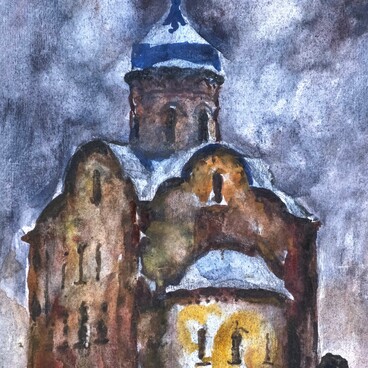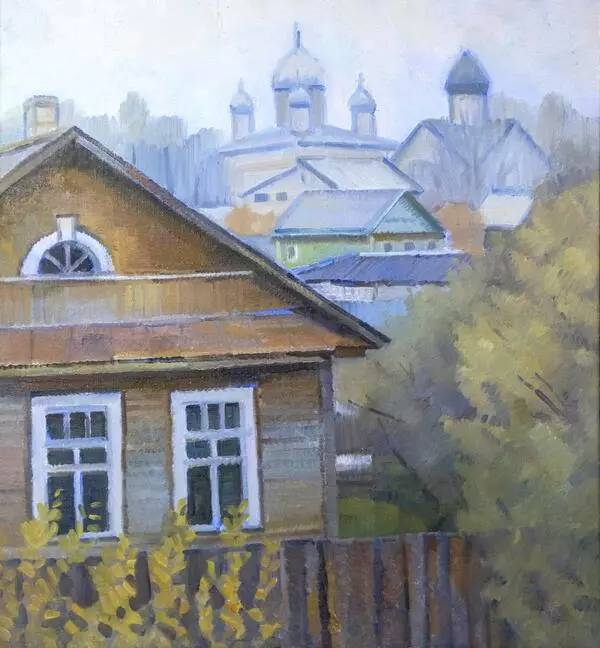Novgorod was known in Rus as the main city of merchants, “people in trade”. It is located two versts (about 2 km) away from the place where the Volkhov flows out of Lake Ilmen into Lake Ladoga, and from there to the Baltic Sea. Traveling from Novgorod in a boat using this river route, one could easily reach the upper areas of the Volga and Dnieper. In the old days, with a small population, the role of waterways was much higher than now: laying roads through forests and swamps, and building bridges was a very challenging endeavor.
The Volkhov River divides the city into two parts. It was possible to go from the western Sophia Side to the eastern Trade Side by crossing the Great Bridge connecting them.
In the 10th century, residential buildings began to be built on the Trade Side; at the same time, apparently, the Trade Mart also opened. In the 10th–12th centuries there was only one “end” (district) — the Slavensky End, later a part of it became the Carpenter’s End.
In the 11th century, a princely residence was located there called Yaroslav’s Court. This name was fixed for the central part of the Trade Side. A huge square with markets and shops was surrounded by several churches, including the St. Nicholas Cathedral and the Church of the Myrrhbearers. There was also a belfry, where the veche (city assembly) gathered. Nearby were Gotsky and German trade yards of foreign merchants and other significant objects.
In the 15th century, Prince Ivan III claimed his hereditary rights to Yaroslav’s Court and sent his people there. In the 16th century, Ivan IV invoked the same right, and the place was popularly known as the “Sovereign’s Court”.
All this diversity is reflected in the painting by Natalia Viktorovna Zakharova. A graduate of the Alexander Herzen Pedagogical Institute (her specialization was “graphic arts”) in Leningrad, and a member of the Artists’ Union, Natalia Viktorovna has been engaged in teaching for a long time, teaching children — art school students — and students of the Novgorod University. Since 2000, she has devoted herself entirely to art: she takes part in various All-Russian and international exhibitions, among them — 10 solo ones. The artist’s paintings are displayed in many art museums of Veliky Novgorod, they are highly appreciated by Russian and foreign collectors. Zakharova’s artistic preferences change periodically, but the lyrical principle and the desire for harmony remain unchanged in her works.
The Volkhov River divides the city into two parts. It was possible to go from the western Sophia Side to the eastern Trade Side by crossing the Great Bridge connecting them.
In the 10th century, residential buildings began to be built on the Trade Side; at the same time, apparently, the Trade Mart also opened. In the 10th–12th centuries there was only one “end” (district) — the Slavensky End, later a part of it became the Carpenter’s End.
In the 11th century, a princely residence was located there called Yaroslav’s Court. This name was fixed for the central part of the Trade Side. A huge square with markets and shops was surrounded by several churches, including the St. Nicholas Cathedral and the Church of the Myrrhbearers. There was also a belfry, where the veche (city assembly) gathered. Nearby were Gotsky and German trade yards of foreign merchants and other significant objects.
In the 15th century, Prince Ivan III claimed his hereditary rights to Yaroslav’s Court and sent his people there. In the 16th century, Ivan IV invoked the same right, and the place was popularly known as the “Sovereign’s Court”.
All this diversity is reflected in the painting by Natalia Viktorovna Zakharova. A graduate of the Alexander Herzen Pedagogical Institute (her specialization was “graphic arts”) in Leningrad, and a member of the Artists’ Union, Natalia Viktorovna has been engaged in teaching for a long time, teaching children — art school students — and students of the Novgorod University. Since 2000, she has devoted herself entirely to art: she takes part in various All-Russian and international exhibitions, among them — 10 solo ones. The artist’s paintings are displayed in many art museums of Veliky Novgorod, they are highly appreciated by Russian and foreign collectors. Zakharova’s artistic preferences change periodically, but the lyrical principle and the desire for harmony remain unchanged in her works.




